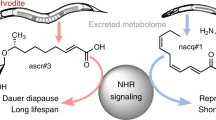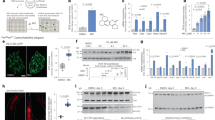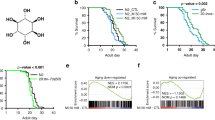Abstract
The DAF-9 cytochrome P450 is a key regulator of dauer formation, developmental timing and longevity in the nematode Caenorhabditis elegans. Here we describe the first identified chemical inhibitor of DAF-9 and the first reported small-molecule tool that robustly induces dauer formation in typical culture conditions. This molecule (called dafadine) also inhibits the mammalian ortholog of DAF-9(CYP27A1), suggesting that dafadine can be used to interrogate developmental control and longevity in other animals.
This is a preview of subscription content, access via your institution
Access options
Subscribe to this journal
Receive 12 print issues and online access
$259.00 per year
only $21.58 per issue
Buy this article
- Purchase on Springer Link
- Instant access to full article PDF
Prices may be subject to local taxes which are calculated during checkout


Similar content being viewed by others
Change history
02 December 2011
In the version of this article initially published, the discovery and synthesis of the dafachronic acids was not attributed properly in two instances. On p. 892, the statement "the DAF-9 cytochrome P450 completes the synthesis of the dafachronic-acid hormones11,13" should have cited references 11, 13 and 14, and the statement "DAF-9 catalyzes two sequential oxidation steps at the C26 position to generate metabolites that are first hydroxylated and then carboxylated to products named Δ4- and Δ7-dafachronic acid, respectively13" should have cited reference 14 instead of 13. The errors have been corrected in the PDF and HTML versions of this article.
References
Riddle, D.L., Swanson, M.M. & Albert, P.S. Nature 290, 668–671 (1981).
Butcher, R.A., Fujita, M., Schroeder, F.C. & Clardy, J. Nat. Chem. Biol. 3, 420–422 (2007).
Kim, K. et al. Science 326, 994–998 (2009).
Georgi, L.L., Albert, P.S. & Riddle, D.L. Cell 61, 635–645 (1990).
Estevez, M. et al. Nature 365, 644–649 (1993).
Kimura, K.D., Tissenbaum, H.A., Liu, Y. & Ruvkun, G. Science 277, 942–946 (1997).
Lin, K., Dorman, J.B., Rodan, A. & Kenyon, C. Science 278, 1319–1322 (1997).
Kwok, T.C. et al. Nature 441, 91–95 (2006).
Antebi, A., Culotti, J.G. & Hedgecock, E.M. Development 125, 1191–1205 (1998).
Jia, K., Albert, P.S. & Riddle, D.L. Development 129, 221–231 (2002).
Gerisch, B., Weitzel, C., Kober-Eisermann, C., Rottiers, V. & Antebi, A. Dev. Cell 1, 841–851 (2001).
Lin, K., Hsin, H., Libina, N. & Kenyon, C. Nat. Genet. 28, 139–145 (2001).
Held, J.M. et al. Aging Cell 5, 283–291 (2006).
Motola, D.L. et al. Cell 124, 1209–1223 (2006).
Antebi, A., Yeh, W.H., Tait, D., Hedgecock, E.M. & Riddle, D.L. Genes Dev. 14, 1512–1527 (2000).
Ludewig, A.H. et al. Genes Dev. 18, 2120–2133 (2004).
Ortiz de Montellano, P.R., Correia, M. & Ortiz de Montellano, P. in Cytochrome P450 (ed. Ortiz de Montellano, P.R.) 247–322 (Springer US, 2005).
Schenkman, J.B., Remmer, H. & Estabrook, R.W. Mol. Pharmacol. 3, 113–123 (1967).
Holzenberger, M. et al. Nature 421, 182–187 (2003).
Gerisch, B. et al. Proc. Natl. Acad. Sci. USA 104, 5014–5019 (2007).
Petrascheck, M., Ye, X. & Buck, L.B. Nature 450, 553–556 (2007).
Evason, K., Huang, C., Yamben, I., Covey, D.F. & Kornfeld, K. Science 307, 258–262 (2005).
Cho, S.C. et al. Proc. Natl. Acad. Sci. USA 107, 19326–19331 (2010).
Burns, A.R. et al. Nat. Chem. Biol. 6, 549–557 (2010).
Vowels, J.J. & Thomas, J.H. Genetics 130, 105–123 (1992).
Acknowledgements
We thank A. Antebi, N. Strushkevich, Y. Kohara, H.-J. Knölker, R. Martin, K.S. Pang, D. Mangelsdorf, R. Auchus, S. Wu, A. Orellana and J. Lund for reagents and advice. This work was supported by Canadian Institutes of Health Research grants to P.J.R. (MOP-68813), C.L.C. (MOP-97904), G.G. (MOP-81340) and C.N. (MOP-84305), a Natural Sciences and Engineering Research Council grant to C.L.C. (356873-08), a grant from the Canadian Cancer Society to G.G. (020380), and a Marie Curie fellowship to I.M.W. G.G. and P.J.R. are Canadian Research Chairs in Chemical Biology and Molecular Neurobiology, respectively.
Author information
Authors and Affiliations
Contributions
P.J.R., C.L.C. and G.M.L. conceived of the experiments and wrote the manuscript. G.M.L. and R.P. did all the worm experiments. L.M. and C.L.C. did all the cell culture and in vitro experiments. G.G. and C.N. provided the NovaCore library, expertise and guidance. G.M.L. and M.L.U. screened the NovaCore library for bioactivity in yeast. I.M.W. did the chemoinformatics.
Corresponding authors
Ethics declarations
Competing interests
The authors declare no competing financial interests.
Supplementary information
Supplementary Text and Figures
Supplementary Methods, Supplementary Figures 1–11 and Supplementary Tables 1–4 (PDF 6302 kb)
Rights and permissions
About this article
Cite this article
Luciani, G., Magomedova, L., Puckrin, R. et al. Dafadine inhibits DAF-9 to promote dauer formation and longevity of Caenorhabditis elegans. Nat Chem Biol 7, 891–893 (2011). https://doi.org/10.1038/nchembio.698
Received:
Accepted:
Published:
Issue Date:
DOI: https://doi.org/10.1038/nchembio.698
This article is cited by
-
A drug-like molecule engages nuclear hormone receptor DAF-12/FXR to regulate mitophagy and extend lifespan
Nature Aging (2023)
-
Sexual morph specialisation in a trioecious nematode balances opposing selective forces
Scientific Reports (2022)
-
The marginal cells of the Caenorhabditis elegans pharynx scavenge cholesterol and other hydrophobic small molecules
Nature Communications (2019)
-
Small-molecule pheromones and hormones controlling nematode development
Nature Chemical Biology (2017)
-
Erratum: Corrigendum: Dafadine inhibits DAF-9 to promote dauer formation and longevity of Caenorhabditis elegans
Nature Chemical Biology (2012)



